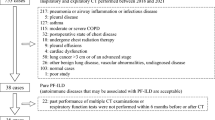Abstract
Purpose
To evaluate the correlation between measurements from quantitative thoracic high-resolution CT (HRCT) analysis with “Computer-Aided Lung Informatics for Pathology Evaluation and Rating” (CALIPER) software and measurements from pulmonary function tests (PFTs) in patients with idiopathic inflammatory myopathies (IIM)-associated interstitial lung disease (ILD).
Methods
A cohort of patients with IIM-associated ILD seen at Mayo Clinic was identified from medical record review. Retrospective analysis of HRCT data and PFTs at baseline and 1 year was performed. The abnormalities in HRCT were quantified using CALIPER software.
Results
A total of 110 patients were identified. At baseline, total interstitial abnormalities as measured by CALIPER, both by absolute volume and by percentage of total lung volume, had a significant negative correlation with diffusing capacity for carbon monoxide (DLCO), total lung capacity (TLC), and oxygen saturation. Analysis by subtype of interstitial abnormality revealed significant negative correlations between ground glass opacities (GGO) and reticular density (RD) with DLCO and TLC. At one year, changes of total interstitial abnormalities compared with baseline had a significant negative correlation with changes of TLC and oxygen saturation. A negative correlation between changes of total interstitial abnormalities and DLCO was also observed, but it was not statistically significant. Analysis by subtype of interstitial abnormality revealed negative correlations between changes of GGO and RD and changes of DLCO, TLC, and oxygen saturation, but most of the correlations did not achieve statistical significance.
Conclusion
CALIPER measurements correlate well with functional measurements in patients with IIM-associated ILD.


Similar content being viewed by others
References
Connors G, Christopher-Stine L, Oddis C et al (2010) Interstitial lung disease associated with the idiopathic inflammatory myopathies: what progress has been made in the past 35 years? Chest 138:1464–1474
de Lauretis A, Veeraraghavan S, Renzoni E (2011) Connective tissue disease-associated interstitial lung disease: how does it differ from IPF? How should the clinical approach differ? Chronic Respir Dis 2011(8):53–82
Flaherty KR, Mumford JA, Murray S et al (2003) Prognostic implications of physiologic and radiographic changes in idiopathic interstitial pneumonia. Am J Respir Crit Care Med 168:543–548
Collard HR, King TE Jr, Bartelson BB et al (2003) Changes in clinical and physiologic variables predict survival in idiopathic pulmonary fibrosis. Am J Respir Crit Care Med 168:531–537
The Joint Statement of the American Thoracic Society (ATS) et al (2000) American Thoracic Society/European Respiratory Society International Multidisciplinary Consensus Classification of the Idiopathic Interstitial Pneumonias. Am J Respir Crit Care Med 161:646–664
Zavaletta VA, Bartholmai BJ, Robb RA (2007) High resolution multidetector CT-aided tissue analysis and quantification of lung fibrosis. Acad Radiol 14:772–787
Maldonado F, Moua T, Rajagopalan S et al (2014) Automated quantification of radiologic patterns predicts survival in idiopathic pulmonary fibrosis. Eur Respir J 43:204–212
Beigelman-Aubry C, Hill C, Guibal A et al (2005) Multi-detector row CT and postprocessing techniques in the assessment of diffuse lung disease. Radiographics 25:1639–1652
Bartholmai BJ, Raghunath S, Karwoski RA et al (2013) Quantitative computed tomography imaging of interstitial lung diseases. J Thorac Imaging 28:298–307
Jacob J, Bartholmai BJ, Rajagopolan S et al (2017) Automated computer-based CT stratification as a predictor of outcome in hypersensitivity pneumonitis. Eur Radiol. doi:10.1007/s00330-016-4697-4
Bohan A, Peter JB (1975) Polymyositis and dermatomyositis (first of two parts). N Engl J Med 292:344–347
Katzenstein AL, Myers JL (1998) Idiopathic pulmonary fibrosis. Clinical relevance of pathological classification. Am J Respir Crit Care Med 157:1301–1315
Miller MR, Hankinson J, Brusasco V et al (2005) ATS/ERS task force. Standardisation of spirometry. Eur Respir J 26:319–338
Miller A, Thornton JC, Warshaw R et al (1983) Single breath diffusing capacity in a representative sample of the population of Michigan, a large industrial state. Predicted values, lower limits of normal, and frequencies of abnormality by smoking history. Am Rev Respir Dis 127:270–277
Harris PA, Taylor R, Thielke R et al (2009) Research electronic data capture (REDCap)-A metadata-driven methodology and workflow process for providing translational research informatics support. J Biomed Inform 42:377–381
Hu S, Hoffman EA, Reinhardt JM (2001) Automatic lung segmentation for accurate quantitation of volumetric X-ray CT images. IEEE Trans Med Imaging 20:490–498
Shikata H, McLennan G, Hoffman EA et al (2009) Segmentation of pulmonary vascular trees from thoracic 3D CT images. Int J Biomed Imaging 2009:636240
Suliman YA, Dobrota R, Huscher D et al (2015) Pulmonary function tests: high rate of false-negative results in the early detection and screening of scleroderma-related interstitial lung disease. Arthritis Rheumatol 67:3256–3261
Funding
This project was supported by CTSA Grant Number UL1 TR000135 from the National Center for Advancing Translational Science (NCATS). Its contents are solely the responsibility of the authors and do not necessarily represent the official views of the NIH. Katelynn M. Wilton was supported by the National Institute of General Medical Sciences (T32 GM 65841).
Author information
Authors and Affiliations
Corresponding author
Ethics declarations
Conflict of interest
None.
Ethical Approval
Approval for this study was obtained from the Mayo Clinic institutional review boards (Mayo Clinic IRB 11-007355). All procedures performed in studies involving human participants were in accordance with the ethical standards of the institutional and/or national research committee and with the 1964 Helsinki Declaration and its later amendments or comparable ethical standard.
Informed Consent
The need for informed consent was waived.
Additional information
Patompong Ungprasert and Katelynn M. Wilton are the Co-first authors.
Rights and permissions
About this article
Cite this article
Ungprasert, P., Wilton, K.M., Ernste, F.C. et al. Novel Assessment of Interstitial Lung Disease Using the “Computer-Aided Lung Informatics for Pathology Evaluation and Rating” (CALIPER) Software System in Idiopathic Inflammatory Myopathies. Lung 195, 545–552 (2017). https://doi.org/10.1007/s00408-017-0035-0
Received:
Accepted:
Published:
Issue Date:
DOI: https://doi.org/10.1007/s00408-017-0035-0




